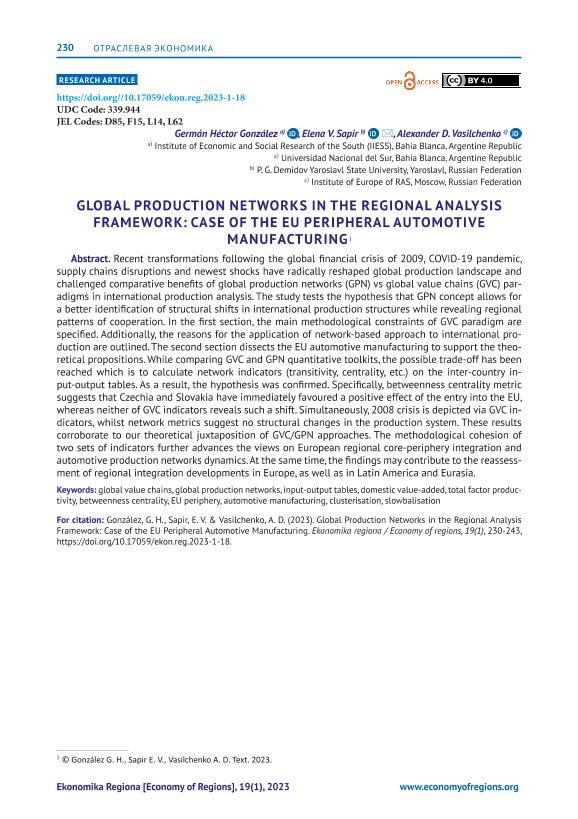Artículo
Recent transformations following the global financial crisis of 2009, COVID-19 pandemic, supply chains disruptions and newest shocks have radically reshaped global production landscape and challenged comparative benefits of global production networks (GPN) vs global value chains (GVC) paradigms in international production analysis. The study tests the hypothesis that GPN concept allows for a better identification of structural shifts in international production structures while revealing regional patterns of cooperation. In the first section, the main methodological constraints of GVC paradigm are specified. Additionally, the reasons for the application of network-based approach to international production are outlined. The second section dissects the EU automotive manufacturing to support the theoretical propositions. While comparing GVC and GPN quantitative toolkits, the possible trade-off has been reached which is to calculate network indicators (transitivity, centrality, etc.) on the inter-country input-output tables. As a result, the hypothesis was confirmed. Specifically, betweenness centrality metric suggests that Czechia and Slovakia have immediately favoured a positive effect of the entry into the EU, whereas neither of GVC indicators reveals such a shift. Simultaneously, 2008 crisis is depicted via GVC indicators, whilst network metrics suggest no structural changes in the production system. These results corroborate to our theoretical juxtaposition of GVC/GPN approaches. The methodological cohesion of two sets of indicators further advances the views on European regional core-periphery integration and automotive production networks dynamics. At the same time, the findings may contribute to the reassessment of regional integration developments in Europe, as well as in Latin America and Eurasia. Экономические изменения вследствие глобального финансового кризиса 2009 г., пандемии COVID-19, сбоев в цепочках поставок и других потрясений привели к радикальной трансформации производственного ландшафта. Возник вопрос относительно сравнительных преимуществ парадигм глобальных производственных сетей (ГПС) и глобальных цепочек создания стоимости (ГЦСС) в анализе международного производства. В связи с этим была проверена гипотеза, предполагающая, что концепция ГПС позволяет лучше идентифицировать сдвиги, возникающие в международных производственных структурах, при этом выявляются региональные модели сотрудничества. В первом разделе рассмотрены основные методологические ограничения концепции ГЦСС, а также изложены причины применения сетевого подхода к анализу международного производства. Для подтверждения теоретических предположений во втором разделе была исследована сфера автомобилестроения в Европейском союзе. При сравнении количественных инструментов ГПС и ГЦСС был достигнут возможный компромисс, заключающийся в расчете сетевых показателей (транзитивность, центральность и т. д.) с использованием межстрановых таблиц «затраты — выпуск». В результате исследования поставленная гипотеза была подтверждена. В частности, показатель центральности продемонстрировал положительный эффект от вступления в ЕС для Чехии и Словакии, тогда как ни один из индикаторов ГЦСС не показал подобных сдвигов. В то же время индикаторы ГЦСС отметили влияние кризиса 2008 г., тогда как сетевые показатели свидетельствуют об отсутствии структурных изменений в производственной системе в исследуемый период. Полученные данные подтверждают теоретическое сопоставление подходов ГПС и ГЦСС. Методологическое единство двух наборов показателей позволило шире взглянуть на европейскую региональную интеграцию ядра и периферии и динамику сетей автомобилестроения. Результаты исследования могут быть использованы для переосмысления процессов региональной интеграции как в Европе, так и в Латинской Америке и Евразии.
Global Production Networks in the Regional Analysis Framework: Case of EU Peripheral Automotive Manufacturing
Título:
Региональный анализ глобальных производственных сетей: опыт автомобилестроения в периферийных странах европейского союза
Fecha de publicación:
30/03/2023
Editorial:
Institute of Economics of the Ural Branch of the Russian Academy of Sciences
Revista:
Economy of Regions
ISSN:
2072-6414
e-ISSN:
2411-1406
Idioma:
Inglés
Tipo de recurso:
Artículo publicado
Clasificación temática:
Resumen
Archivos asociados
Licencia
Identificadores
Colecciones
Articulos(IIESS)
Articulos de INST. DE INVESTIGACIONES ECONOMICAS Y SOCIALES DEL SUR
Articulos de INST. DE INVESTIGACIONES ECONOMICAS Y SOCIALES DEL SUR
Citación
González, Germán Héctor; Sapir, Elena; Vasilchenko, Alexander; Global Production Networks in the Regional Analysis Framework: Case of EU Peripheral Automotive Manufacturing; Institute of Economics of the Ural Branch of the Russian Academy of Sciences; Economy of Regions; 19; 1; 30-3-2023; 230-243
Compartir
Altmétricas




